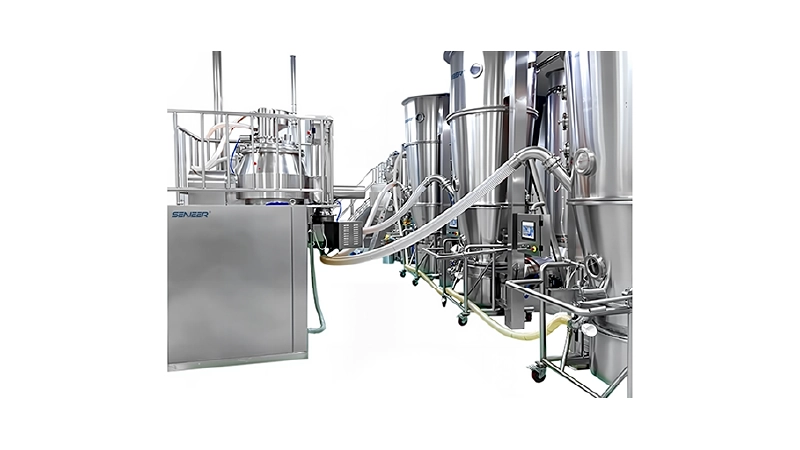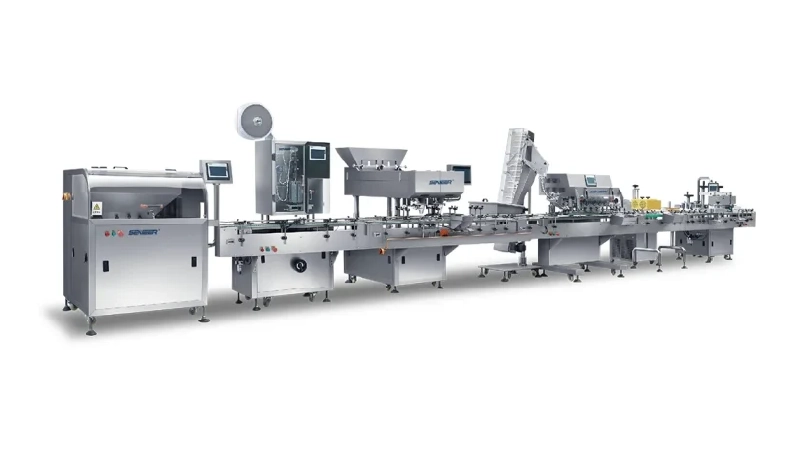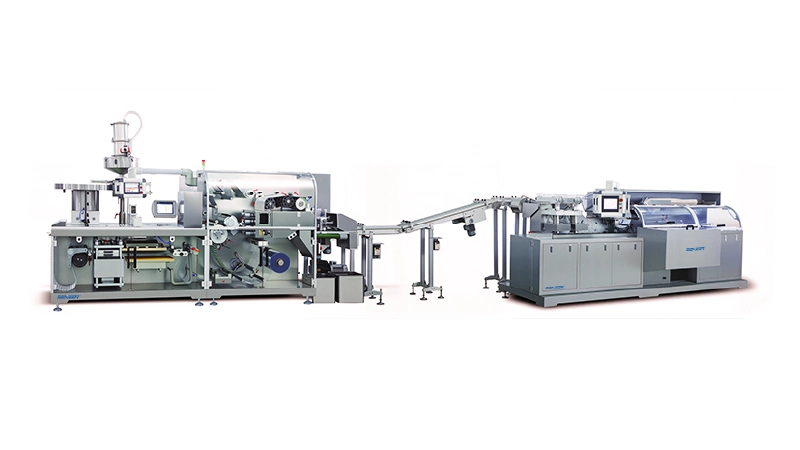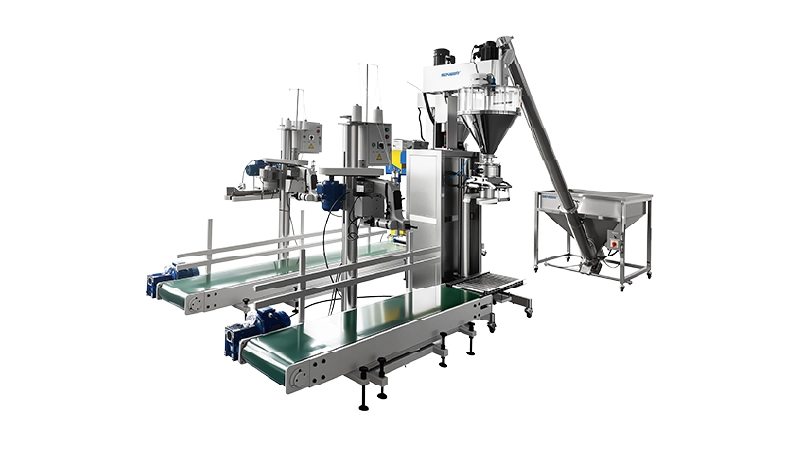Part 1 Fluid Bed Granulation Theory
The fluidized bed granulation mixing process is especially suitable for materials with a particle size range of 50-200 μm. The fluidization behavior of particles is the sum of the forces and interactions between various particles. When the air flow through the material bed is large enough, the particles can be fluidized against gravity. At low air inlet velocities, the velocity of the particles is proportional to the pressure drop in the fluidized bed. As the air inlet velocity increases, the particles in the fluidized bed change from stationary to suspended, and the corresponding airflow velocity at this time is the minimum fluidization velocity (Umf). The minimum fluidization velocity is a primary lower limit in the one-step granulation process. As the granulation process progresses, the minimum fluidization velocity should change and increase gradually. The fluidization velocity of the granulation process should be greater than the minimum fluidization velocity, so that the coarse and fine particles will not be separated.
When the fluidization velocity is higher than the minimum fluidization velocity, the material in the fluidized bed moves like a violently boiling liquid, and there are bubbles at the bottom of the material bed (formed near the bottom of the fluidized bed, near the air distribution plate), and in the Under the action of the fan, it rises rapidly to the surface and ruptures. It can also be seen that the design of the gas flow distribution plate has a significant impact on the characteristics of the fluidized bed. As the fluidization velocity increases, the volume of the powder expands, and the particle density per unit volume in the bed decreases. When the fluidization speed reaches a certain speed, the particles will be blown away, and the speed at this time is called the entrainment speed. The degree of mixing in fluidized bed granulation is related to the particle size and the way the airflow moves through the material. The way the airflow moves affects the heat transfer between the gas and the particles.
The standard air inlet speed is usually 1.0~2.0m/s. For agglomerated materials, the required air flow rate is five to six times the minimum fluidization velocity. Drying requires low speed, such as 0.8-1.4m/s. Due to the presence of wet material in the fluidized bed, higher speeds are required in the early stages of drying, but the air speed is usually reduced as the product loses moisture, in order to ensure good particle movement and prevent material from entering the filter. In the fluid bed granulation process, particle movement and fast drying are important. The free flow of particles in the observation hole of the fluidized bed is a good granulation state, and the bad fluidization state can also be monitored through the outlet air temperature. Each product has a constant drying rate, where the temperature within the fluidized bed remains relatively constant for a considerable period of time. If the rate of rise in the outlet air temperature is faster than expected, it indicates poor fluidization conditions, granulation may have to be stopped, and manual or mechanical intervention is required to assist fluidization.
Part 2 Particle Aggregation And Growth Mechanism
Aggregation is the process of increasing particle size with fine particles as the starting material. There are three main mechanisms for particle growth:
- Due to the presence of stagnant liquid on the particle surface, a bonding liquid bridge is formed, which can promote the bonding of fine particles;
- The existence of interfacial force and capillary pressure makes the particles compact;
- Formation of solid bridges due to crystallization of dissolved substances during drying.
Ideally, the primary particles in the fluidized bed come into contact with the wetting agent droplets when they pass through the spray zone, and the wetting agent diffuses on the surface of the particles to wet the particles. At the same time, the particles collide with each other to form a liquid bridge, and then dry and solidify in the fluidized bed to form particles.
The factors affecting the fluidized bed granulation process can be divided into three categories: formulation-related variables, equipment-related variables and process-related variables.
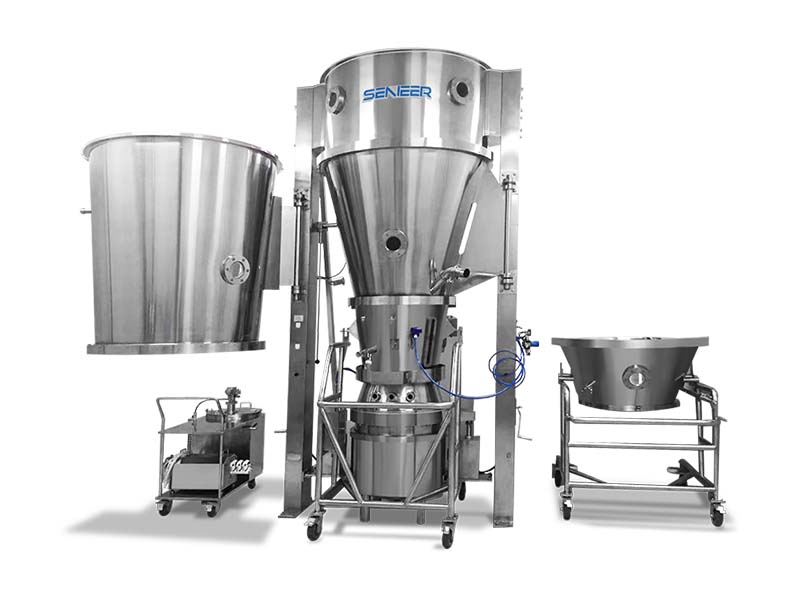
Formulation-related variables: Ideal starting materials for one-step granulation should have low density (small density difference), small particle size, narrow particle size distribution, and a nearly spherical shape. The cohesion, static electricity, particle size distribution, crystalline or amorphous nature, and wettability of the material can affect the properties of the particles. Fluidization difficulties can occur when the formulation material contains hydrophobic materials or a mixture of hydrophilic and hydrophobic materials. The hydrophobicity of the mixture increases, resulting in reduced particle growth. The effect of one-step granulation of hydrophobic materials can be improved by adding surfactants (such as sodium lauryl sulfate, SDS). Binders: Different binders have different binding properties, and the type of binder, the amount of binder in the formulation and the concentration of binder have a major impact on particle properties.
The way the binder is added will also affect the properties of the granules. Some studies have found that adding ethanol to the binder to granulate the granules has a larger particle size, but when the binder is added to the solution, the granulated granules are not brittle and have fluidity. it is good. The temperature of the binder affects the viscosity of the solution, which in turn affects the droplet size. As the temperature of the binder solution increases, the viscosity of the solution decreases, thereby reducing the particle size of the droplets, so the average particle size of the prepared particles is smaller. The viscosity and concentration of the binder solution will affect the size of the binder droplets. As the viscosity of the binder increases, the droplets formed are larger and the resulting particles are larger in size.
Equipment-dependent variables: Agglomeration and attrition due to random fluidization, need to control particles during granulation. This is a complex process because the prevailing fluidization conditions and particle size distribution change during the process. When conditioned air is introduced through the lower plenum of a fluidized bed, the fluidization velocity for a given volume of air determines how fluidization is achieved.
The air distribution plate provides a suitable method of supplying air to the product. It is mainly identified by its open area percentage. Typically, an air distribution plate with an open area of 4% to 30% can be used. These interchangeable air distribution plates or air distribution plates with adjustable openings are available in a range of loading capacities for efficient and uniform production. To prevent play, the operator can select the air distribution plate with the best lifting performance. An air distribution plate with a small open area to create a large enough pressure drop ensures that the product fluidizes evenly without clogging the filter. Alternatively, products with a higher bulk density can be fluidized using an air distribution plate with a larger opening area.
The geometry of the fluidized bed is a factor that can affect the granulation process. The fluidization velocity must drop by more than half from the bottom of the fluidized bed to the top edge to prevent smaller lighter particles from being blown into the filter and thus separated from the heavier product in the fluidized bed. A generally conical vessel and expansion chamber is preferred, where the ratio of the cross-sectional diameter of the flow distribution plate to the diameter of the vessel top is 1:2.
Process-related variables: The fluidized bed granulation process is a dynamic process in which mist droplets are generated by a spray gun and deposited on randomly fluidized granules. The adhesive solvent evaporates, leaving the adhesive behind. Other random particles bond in contact with the wet particles until all the solvent has evaporated. This process is repeated several times to produce the desired particles. There are many process variables that control granulation. The most important process variables are: process inlet air temperature, atomization pressure, air fluidization velocity and volume, liquid spray velocity, position and number of spray guns, material temperature and outlet air temperature, filter porosity and reaction Blowing frequency, fluidized bed volume.
These process parameters are interdependent, and if this interdependence can be understood, the desired product can be produced. The inlet air temperature depends on the choice of binder carrier and the heat sensitivity of the particles formed. Generally, the aqueous solution allows the use of the inlet air temperature range of 60°C-100°C. Organic solvents need to use an inlet air temperature of 50°C to below room temperature. Higher inlet air temperature will rapidly evaporate the binder solvent, which will form smaller brittle particles.
Part 3 Conclusion
The fluid bed granulation process is a robust process that requires precise and repeatable control of all critical process parameters. Effective and reliable process control tools are required to ensure the quality of the final product.






